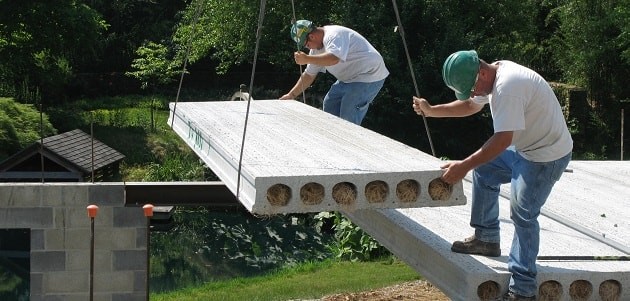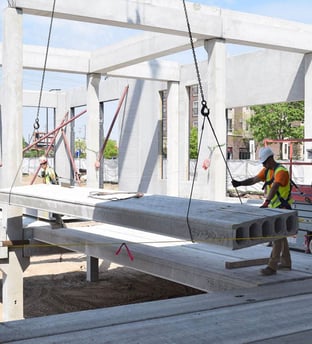Want quick responses to our most asked precast questions? Our blog series, “FAQ Fridays,” is designed to answer your most popular questions, organized by topic and product category. In Part 6 of this series, we discuss the Hollow Core Plank/Roof and Floor Systems.
PCI Mid-Atlantic hollow core manufacturers have engineers on staff who are very familiar with the requirements for submittals, design, materials, concrete mixes, product delivery, storage, erection, field welding, and attachments. It is customary for the precast producer to perform the final engineering for the product to be supplied to the job. This includes loads specified by the engineer of record, embedded items, handling, shipping, etc. It is very important that the engineer of record ensures that the specified floor and roof system is achievable prior to the selection of a producer. PCI-certified Mid-Atlantic precasters can provide input on span lengths and openings as well as the latest innovations in connection technology and techniques to use hollow core to its best advantage. This article answers some of the most common questions our experts have had in regard to this subject.
What kind of span lengths can be achieved with hollow core plank systems?
The design recommendations for span lengths vary slightly from product to product, but here are a few general rules of thumb to keep in mind. If we assume a uniform superimposed load of 100 pounds per square foot and an un-topped system, these guidelines apply:
- 6-inch depth hollow core plank: 22-foot spans
- 8-inch depth hollow core plank: 29-foot spans
- 10-inch depth hollow core plank: 35-foot spans
- 12-inch depth hollow core plank: 40-foot spans
- 16-inch depth hollow core plank: 50-foot spans
Factors such as concentrated loads and large openings can affect the span capabilities of your system. Once you have determined the given loadings, fire endurance ratings, span lengths, and slab thickness for your project, consult a local PCI-certified Mid-Atlantic producer for their published load tables.
How do we design for openings in plank?
Openings may be provided in hollow core systems by forming openings in the plant, installing steel headers, shoring and saw cutting, or cutting after a deck is installed and grouted. In laying out openings for a project, the least structural effect will be obtained by orienting an opening parallel to a span or coring small holes to cut the fewest prestressing strands.
An opening greater than 2' x 2' should be cast into 8'-0" wide hollow core plank. This would usually occur if the plank were a wet-cast product. The opening could be plant or field cut in an extruded or dry-cast product. If the size of the opening exceeds the safe limitations of cast in the use of a structural header is used to create the required opening.
Openings less than 2-feet can be cast in or field cut in the plank providing that all the pertinent information (location and size) is provided to the precaster prior to manufacturing. The general contractor must coordinate with all trades involved to get information to the hollow core manufactured during the shop drawing phase so that additional reinforcement can be designed into the plank to carry the required design loads. An opening smaller than 10" square can’t be cast into a plank due to production limitations.
Small openings are typically core drilled in the field by the trade (plumbing, electrical, etc.) involved after the plank has been installed and grouted. Again, the location and size of these openings should be provided to your PCI-certified precaster during the shop drawing phase so that the plank can be designed to accommodate these cores. Please do NOT cut prestressing strand in the plank without the approval of the hollow core manufacturer.

What should be shown on the drawings for a precast hollow core plank project?
Please contact a regional PCI-certified hollow core manufacturer when considering a precast design. They are most helpful in the early stages of a project and can guide you through the process. Typically, the following information would be provided to the precaster on the drawings:
- Span directions
- Loading requirements
- Connection information
- Diaphragm steel
- Grouting requirements
- Fire Resistance requirements
- Topping requirements (for example ¾” leveling coat; or 2” composite or non-composite topping)
- Openings: sizes and locations
Click here to find a PCI-certified hollow core producer in the Mid-Atlantic area.
Should hollow core plank be used in an exterior application for balcony sections in the high-rise I’m designing?
Residential construction is an ideal application for hollow core plank. However, we are all familiar with the hot, humid summers and the cold, wet winters of the Mid-Atlantic region. There is the potential for problems due to water infiltration and subsequent freeze/thaw damage in the hollow cores when used in an external application. All PCI-certified Mid-Atlantic precasters of hollow core plank recommend that you specify that the cores be filled for the balcony area or plan for that piece(s) to be solid slab section. This is easily and commonly manufactured for high rise, multifamily residential projects.
Is it common practice to weld alternate ends of the hollow core plank? When is this practical?
Connections are required in hollow core slab systems for a variety of reasons. Most are for localized forces. Connections are an expense to a project and, if used improperly, may have detrimental effects by not accommodating volume changes or other movements that occur in a precast structure. Connections may develop forces as they restrain these movements. In specifying connections, the actual forces must be addressed. If no force can be shown to exist, the connection should not be used.
The precast engineer often makes recommendations to the engineer of record regarding industry common practices. Typically, for buildings over 100-feet in length, with hollow core set on structural steel, the precast floor system would require only one hard connection. This is accomplished by specifying a welded connection at opposite or alternating ends of the plank. The entire slab is then grouted in the normal manner. This allows the thermal movement in the floor slab to occur without damage to the embedded weld plates. This practice makes sense for a structural steel frame, but not for hollow core bearing on masonry, nor total precast concrete systems. The practice is to avoid over-restrained systems for large footprints.
It is always a good idea to discuss your concerns with a PCI-certified precast manufacturer before production and construction begins.
How do I determine the fire rating or resistance of hollow core plank? Should I specify a UL rating?
Like all precast, prestressed concrete products, hollow core slabs have excellent fire resistance. Depending on thickness and strand cover, ratings up to a 4-hour endurance can be achieved. A fire rating is dependent on equivalent thickness for heat transmission, cover over the prestressing strand for strength in a high temperature condition, and end restraint. Underwriters Laboratory (UL) publishes fire ratings for various assemblies. The fire ratings should be considered in determining the slab thickness to be used in preliminary design.
A typical 8” thick hollow core plank has a 2-hour fire rating. For a higher rating (3- or 4- hours), typically a concrete (or gypsum based) topping would be applied or a spray-on fire resistant material can be added to the underside of the plank. This is also shown in the UL directory.
Model codes like the IBC have prescriptive fire ratings. This is the best way to indicate ways to accomplish specified fire ratings and should be the first choice. UL listings are another way to indicate how to achieve the specified fire ratings. The code does not require that UL listings be provided. These listings are the result of proprietary tests on specific precast units produced and tested by specific companies. If UL labels or numbers are required, then the specific details in the UL Directory are exactly and only what will meet this requirement.
PCI’s MNL-124 Manual Design for Fire Resistance of Precast/Prestressed Concrete illustrates the code accepted practice of rational fire design for precast and prestressed concrete products. In the case of hollow core, an equivalent thickness is calculated based on the cross-sectional properties of each brand of hollow core. Rational fire design is used for situations not covered by the code.
The engineer of record will decide if the floor slabs can be considered restrained or un-restrained. Tables in ASTM E119 discuss the restraint conditions and are also shown in the MNL-126 PCI Hollow Core Design Manual. Required fire ratings should be clearly specified in the contract documents.
To download these referenced manuals, please click the links below. Note: there is a charge for the MNL-124 publication.
- MNL-124 Design for Fire Resistance of Precast/Prestressed Concrete
- MNL-126 PCI Manual for the Design of Hollow Core Slabs and Walls
What is camber and how can it be addressed when specifying hollow core plank?
It is common for precast, prestressed hollow core slabs to exhibit camber or upward deflection. Camber is not designed into the product, it is inherent to prestressing that allows for the long spans and load carrying capability in hollow core applications. Realizing the benefits of a high-performance hollow core floor system is the result of design considerations that include (material savings), maximizing spans (architectural openness), meeting load demand (structural integrity), controlling deflections (serviceability), and providing fire resistance (life safety). A discussion with your PCI-certified hollow core manufacturer is critical regarding topping thickness that delivers a uniform finished floor surface while taking advantage of the sound isolation, fire resistive properties and many other benefits of hollow core on your next project.

Should there be weep holes in the hollow core plank? Why?
Yes, it is recommended. Water can get “trapped” in the hollow cores after installation. It is recommended to drill weep holes on the underside of the plank at each individual hollow core. If the underside is to remain exposed, specify patching of the weep holes after the building is watertight and has been conditioned to a stable above freezing temperature.
Water can become trapped from precipitation prior to a watertight building; from wet trades or wet cleaning in the building after the plank is installed. Trapped water can also freeze in the winter then thaw out when warmer and find its way to come out and damage any finishes that may have been installed.
Trapped frozen water in the hollow cores can also create the hollow core to crack and spall.
Should you caulk the underside joints of hollow core planks?
This is only necessary if desired; for example, if the underside remains exposed and or just painted.
Can you paint the underside of hollow core planks?
Yes, however make special notes for surface preparations required the paint application. Understand the finish expectations and PCI acceptable range for air holes.
For more information regarding hollow core plank design considerations, check out our Hollow Core Roof and Floor Design Checklist.
Want to work with precast concrete in your upcoming projects? Explore helpful tools, detailed information on working with precast, and expert guidance to support your next project in our Solutions Center.





